Photo: This is not a lake, but is instead a normally dry pasture covered with fourteen inches of rain from Hurricane Harvey.
Last August Hurricane Harvey tarried around for a while and caused significant damage to our roof and the front of our house. The front was added in the 1950s to a house built of cypress in 1908 by my great-grandfather. The older part of the house was fine. The roof we lost was a metal roof recently placed over the old roof. Our insurance finally paid off on the damage a couple of months ago. Susie (wife) negotiated with contractors to replace the roof and build a new front for the house. I’m a zoologist and can handle anything that breathes, bleeds, and breeds. Houses don’t do that, so Susie, a wannabe architect and contractor, handles construction. My role is relegated to demolition, which we decided to do ourselves due to the lack of available workers. Harvey is a full-employment agency for carpenters, fence builders, etc.
Our contractor plans to start June 26th. We are near completing demolition; if you don’t count the stacks of sheetrock, shingles, plyboard, and other wood, which will need to be sorted, rehabbed, burned, or hauled away at some point. Texas is in drought, this is typically the dry time of the year, and there has been no rain in the forecast, so we weren’t too concerned about not having an intact roof. Most of the roof is under a large blue tarp. Due to demolition, the front part of the roof has a gaping hole. The rest of the exposed roof still has tar shingles over wood shingles and is mostly waterproof.
This morning I planned to complete pulling up the last of the floor decking and then removing the floor joists to complete the demolition phase. In the afternoon, I was going to install another blue tarp to cover the hole in the roof. After lunch Susie was going into town to pick up some spray on sealer (heavily advertised on TV) to create a seal where the tarp met the roof to prevent water running under the tarp. I’d used it the past and found it didn’t hold very long; but I figured it’d last until the contractor replaced the roof.
Around 11:00 am I came in for some tea and a snack. When I put down the crowbars, prybars, and hammers to come in, it was still, hot, and humid. I’d barely sat down to check emails when I noticed gusty winds outside. I checked the weather online. Just to the southwest of us about four miles was an isolated large orange blotch headed directly for us. I scrapped the break and rushed out to gather up the tarp and tools I would need to install it. The sealer would have to wait until later.
By the time I was climbing the ladder, it was raining lightly. By the time I got the tarp opened and started placing in on the roof, it was raining heavily. By the time it quit raining, I had the tarp installed. Fortunately, only a little water made it into the roof’s hole. I’d spread the tarp enough to catch most of the water. The bathroom below the hole only had a small rain shower. The ceiling was made of tongue in groove cypress and there was no sheetrock to be destroyed by the water. By the way, there will be NO sheetrock in the rebuilt portion of the house.
We don’t complain about rain, only it’s lack. Our pastures were very thirsty and our livestock carping about no green grass, so rain is very welcome. But, it could have waited just a few hours! About the “flood” part in the title? Our farm averages about 34 inches of rain a year. If that fell in weekly equal showers, we’d have lush pastures. But, it tends to fall in a few large rains. The last really soaking rains we had were during Hurricane Harvey, which gave us 14 inches, more than a third our last year’s rainfall all in a couple of days. Prior to Harvey, we were in drought. After Harvey we were in drought. Drought, flood, drought, flood, ad infinitum.
As I write this just after noon, another large orange blotch is approaching. Let it rain! The tarp is up.


Leave a Reply